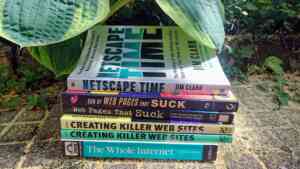Internet Time

“if users have had a rapid performance in previous experience they will expect it in the future”
Ben Schneiderman, 1984
“it was the best of times it was the fastest of times”
Jim Clark, 1999
It’s July 2021, which means I’m 50 and my first art work is going to be 25 in a month. Would be nice to have it the other way round, but where is the algorithmic timeline when you really need it? 🤷♀
I have been a net artist for half of my life! For a quarter of the century!! Or according to WWW father’s (Tim Berners-Lee) calculation made in 1996: "What is a web year now, about three months? [...] we will be able to live for three or four hundred Web years, which will be very exciting." - I lived through a web century already! And it certainly feels like this: at least four “epochs” and five “revolutions” happened on my monitor, not to mention innumerable updates, that could also become life changing events.
TBL’s estimation was not just a figure of speech, he referred to what was in the middle of the last decade of the 20th century called and promoted as Internet Time or Netscape Time. Netscape Communications Corporation, that took over the World Wide Web at that time, aimed to release a new version of their browser four times a year. “It was the fastest of times” as its CEO James Clark recounts on the last page of the Netscape Time (1999). Indeed, there was no present. In 1996 there was only the future. Very uncertain one, for both, developers and users.
The pace known as Netscape Time is not only about velocity, but the dramatism of change that could happen in a very short time. It also made Internet evangelists of that time to multiply online years by seven as an analogy to dog years. Not sure about that. I think that there were also some periods that could count as 100 years. For example 1997 brought dramatic bandwidth price sinking, the Wired cover announcing the death of the web, the release of Netscape Communicator, a new version of the browser which suggested building the Web as an application, not pages -- was too much for one year!
In 1997 the dot.com boom started, also known as the first internet bubble. It burst in 2001, leading to a recession in investments, but also in overall interest and enthusiasm about being or working online. Not the best years for the net art as well. But the next big thing was around the corner. The Web 2.0 revolution, i.e. platformization of the web, came in 2004, bringing a lot of people online and, more importantly, bringing unprecedented order, I would even call it discipline, into our life online, and consequently IRL. We were given a platform where to upload a video, another one to communicate, the third to share CVs… places to publish art were also defined and equipped accordingly.
The Smartphone revolution happening in parallel, not only made the Internet truly 24/7, but also extended this orderliness further. The app paradigm -- “There's an app for that” -- guided users to the right tracks according to the tasks they had to achieve, and keept us there.
We moved or were moved away from the websites to platforms, apps, and a strange unprecedented environment named Timeline.
Well, in the beginning, when Facebook just introduced this new narrative layout “to tell the story of your life” 10 years ago -- it was promoted as a timeline. But since keeping chronological order of events and posts was hardly its function it became known as an algorithmic timeline. Facebook and other IT giants' algorithms dismissed chronological order, a convention that is universal and neutral, one you can rely on, like you can rely on alphabetical order, Euclidean space, and gravity. Algorithmic timeline arranges the content according to its own coordinate system, obscure and liquid.
What are the consequences apart from general discomfort of being in a place that is driven by obscure algorithms? Every algorithmic timeline social network is also a time pyramid or time bubble.
We get perfect tools to feed the timelines: mobile, instant, or even the ones that run in the background (they call them AI). Filters, emojis, voice input, – they are all time amplifiers.
Astronomical hours got augmented again. By 2021 it looks like everybody has three lives or at least 72 hours a day. And as it turns out this is how we are supposed to spend these 300 or 400 web years Tim Berners-Lee was talking about. By generating content and uploading it to one or two particular companies.
But there are no 72 hours a day, at least not for everyone. The time bubble will burst, which by itself is something to look forward to and maybe even try to make happen sooner. On the dark side the content (images, texts, video, interactions you had with others) generated for the obscure system, that dismissed chronological, alphabetical and all other conventions -- will be impossible to access and retrieve. It will be lost, or is already.
But maybe it is an unnecessary remark. Cruel Internet Time running in parallel to seemingly generous, but not less evil Social Network Time for already a decade trained its users to have only the future.
The present is very short. I don’t even know on what scale to count it. In the length of a Tik Tok video? In the life span of an Instagram Story?
The past doesn’t exist. IT companies kill social networks and services easily and rapidly. And “killer apps” are called like this not without a reason. New tools and environments come to erase old ones.
This makes it very easy for the IT industry to turn the time spiral tighter and tighter, making the time in between deleting some product or idea and selling it as a new one again shorter and shorter. At the moment when i write it the concept of “You” is being reanimated by Google in their “Material You” design scheme. Spotify follows the trends and rolls out the “Only You” extension, promising perfect personified playlists. Do you remember “You” being person of the year 2006 on the cover of Time magazine? I bet you don’t.
Very short cycles of trends imposed by IT industry, multiplied by even shorter attention spans of mass media, are creating a lot of challenges for me as an educator -- someone who tries to teach art and design online and its history. Also my work as a vernacular web researcher and archivist is affected dramatically technology- and contentwise. There is more to resque, but less time to develop tools for it.
But as a net artist, I think I've come to terms with it finally, and even start to enjoy and benefit from net art being rediscovered once in a while. Especially because occasions to remind about it are occurring more and more often. Within the last 12 months it happened even twice! First, a year ago when due to the pandemie the whole artworld had to move online, and art critics were faster than museums, they had to pay attention to the native online forms of art and announce that it is the future. Again!
And then, earlier this year, when the crypto industry started to promote Non Fungible Tokens, NFT artists and the “revolutionary” idea that digital art has value and that you can sell it online! Again!
In former times they called it Déjà vu and argued about the reasons for this anomaly of memory. In Internet Time(s) this condition is very easy to explain. The challenge is to learn to live with it through the next web centuries.


